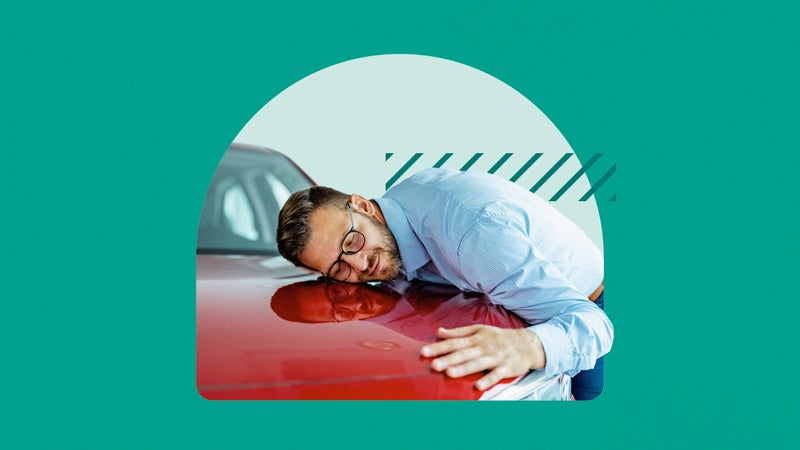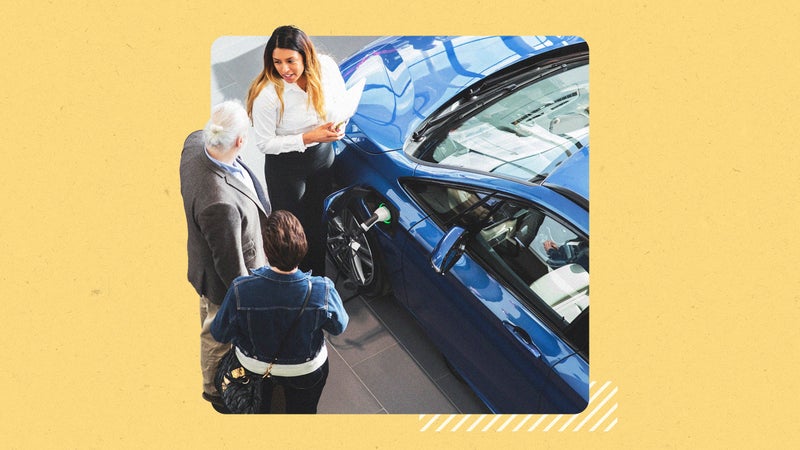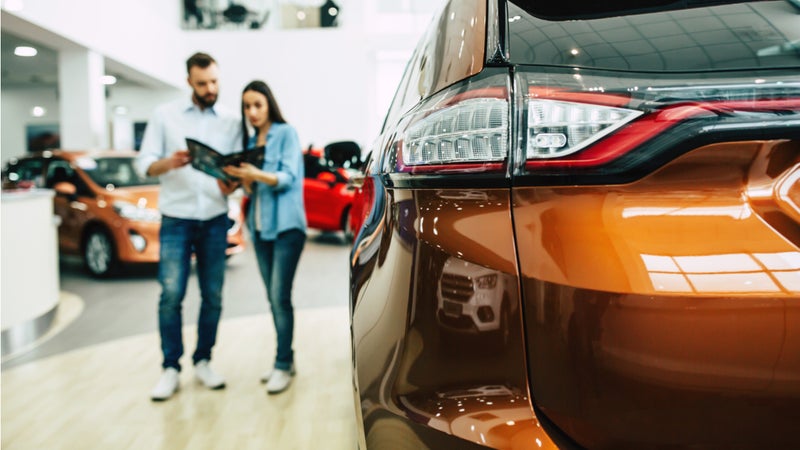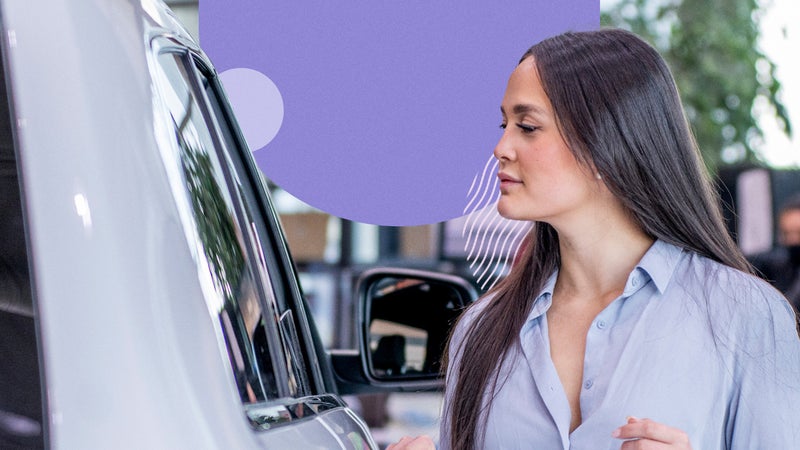Pros and cons of leasing vs. buying a car

The Bankrate promise
At Bankrate we strive to help you make smarter financial decisions. While we adhere to strict , this post may contain references to products from our partners. Here's an explanation for .
Getting a new vehicle is an extremely exciting milestone. But before choosing an SUV or truck in black or red, you must first decide whether to lease or buy your next ride.
Leasing could get you more affordable monthly payments. But the cost savings may not be enough to justify the downsides of leasing, making purchasing a car the better choice.
Leasing a car vs. buying: A summary
Leasing and buying are both valid ways to get your hands on a new vehicle. Buying offers fewer restrictions than leasing on how much you can drive and what you can do with the vehicle. Plus, you own the vehicle at the end of the loan. But leasing is a less expensive option month-to-month if you want to get into a luxury car.
Leasing or buying comes down to these factors: the miles you expect to drive, the amount of money you are willing to spend and the vehicle’s purpose. Use a calculator to determine whether leasing or buying is better for your budget.
Who leasing is best for
Leasing is the right option for you if you want to get behind the wheel of a vehicle without a substantial financial commitment upfront. Leasing eases the monthly cost to a more manageable number. It also allows you to drive a more luxurious vehicle than you might otherwise be able to afford.
But keep in mind the mileage restrictions and potential excess wear-and-tear charges that come along with leasing. If you like long road trips, leasing might not be right for you.
Who buying is best for
If you prefer to be in total control when it comes to your vehicle and finances, buying might be best for you. You won’t have to worry about mileage restrictions or possible additional charges for things like wear and tear.
Although buying or financing your vehicle through a loan takes some extra homework, you will have full control of the vehicle and can sell or trade it in at any time — a benefit that leasing cannot offer.
Leasing a car
When you lease a car, you pay for the right to drive the vehicle for a fixed period — typically three or four years. Most leases are financed through the dealer.
You will need to pay taxes, title fees, licensing fees, dealer documentation fees and prep charges at the lease signing — and, sometimes, you will need to pay a down payment to top it all off. The lease may also come with an acquisition fee or a drive-off fee. This can add up to thousands of dollars.
From there, you will make monthly payments over the life of the lease to cover the costs of the vehicle’s depreciation.
There are typically restrictions on the number of miles you can drive the car during the lease term.
Also, be prepared to be charged for any excessive scratches, door dings, dents, interior stains, upholstery rips or damage from accidents. It may be cheaper to fix the damage yourself before turning in the car than it is to wait for the leasing company’s charges for the same repairs.
Benefits of leasing a car
Leasing comes with an assortment of benefits that can result in significant cost savings.
- Lower payments. If you are trying to keep your monthly spending in check, leasing a newer car tends to cost less month-to-month than buying one.
- Less money down. In addition to what you pay throughout the lease, the initial sticker shock may not be as bad: You might be able to drive off the lot without putting any money down.
- Manufacture warranty options. While you have the keys, you will likely enjoy the benefit of warranty protection, which typically lasts for the first three years or 36,000 miles.
Drawbacks of leasing a car
Unfortunately, leases come with restrictions and other drawbacks worth considering before signing on the dotted line.
- Mileage restrictions. Most leases come with annual mileage restrictions, typically ranging between 10,000 to 15,000 miles. If you exceed those limits, you’ll pay a premium — typically around 30 cents per mile.
- Additional costs. There are also fees for any wear and tear that’s considered “excessive.” This includes anything beyond small scratches and dings.
- Difficult to exit lease. Terminating a lease early is expensive. You can check to see if your contract allows lease transfers, which is the only affordable way to get out of a lease early — provided you can find someone to take over your lease.
- You won’t own it at the end. Unless you choose a lease buyout — which will likely involve financing anyway — your monthly payments will continue when you either renew your lease or lease a new vehicle. This means you are never without payments and never fully own the car.
Buying a car
Buying a vehicle means you maintain possession of the car instead of leasing it for a few years. If you are looking for a brand-new car, it can have a big price tag. The average cost of buying a new vehicle in June 2022 was over $48,000, according to data from Kelley Blue Book.
There are other more affordable options for buying a car, though, including certified pre-owned vehicles (CPO) and used cars.
For new cars purchased with a loan, the price tag for your monthly payments is typically higher than leasing. However, the vehicle is officially yours once it’s paid off.
Benefits of buying a car
Buying allows you to build equity in a valuable asset, along with other benefits.
- No mileage limits. When you buy a car, you won’t have to keep an eye on your mileage. If you want to rack up 100,000 miles in a year, you can do so without worrying about extra fees.
- No wear-and-tear charges. You won’t have to worry about what a dealer deems normal wear and tear.
- The ability to sell or trade in the vehicle. Because the car is yours, you won’t need to think about what to do when your auto loan is paid in full. When you’re ready for a new vehicle, trade in or sell your car at its current market value based on mileage and condition.
Drawbacks of buying a car
Car ownership isn’t without its downsides.
- Higher monthly payments. When you buy a car, you will probably spend more each month. For example, the average monthly payment for those who bought a Honda Civic was $541 — $119 more than an average monthly payment for leasing it, according to Experian’s State of the Automotive Finance Market report for the fourth quarter of 2023.
- A bigger down payment is required. If you put more money down, you can reduce the amount you need to borrow and — by extension — those monthly payments, but it will take a bigger chunk of your savings.
- Long-term maintenance costs. Lastly, owning a car means paying to fix it when something breaks. The warranty may cover some things, but you’ll be fully responsible once that runs out.
Final considerations
Whether you choose to lease or buy a car, it’s important to remember a few key factors.
Your credit score is the primary measure of your ability to afford your monthly payments. Aim for a score between 680 and 740 for leasing, and 660 or higher if you choose to buy.
Here’s why, as indicated in Experian’s State of the Market report:
- The average lease payment for subprime borrowers, or individuals with credit scores between 501 and 600, was $639, compared to $587 for super prime borrowers with credit scores between 781 and 850.
- The average monthly payment for used auto loans was $548 for subprime borrowers and $515, for super prime. Consumers who financed new cars paid $774 and $703 per month, respectively.
Also consider the time of the month, year or even week when you decide to head to the dealership. Holidays or colder months may mean you walk away with a better deal.
The bottom line
Determining whether you should lease or buy a car depends on a careful assessment of your finances and driving habits. Think about how much you can comfortably afford to pay upfront each month and consider how many miles you spend on the road to figure out the most cost-effective way to hit the highway.
When you know what kind of car you want, crunch the numbers with a lease versus buy calculator. Also, shop around for financing and compare your rates to ensure you make the best financial move.





